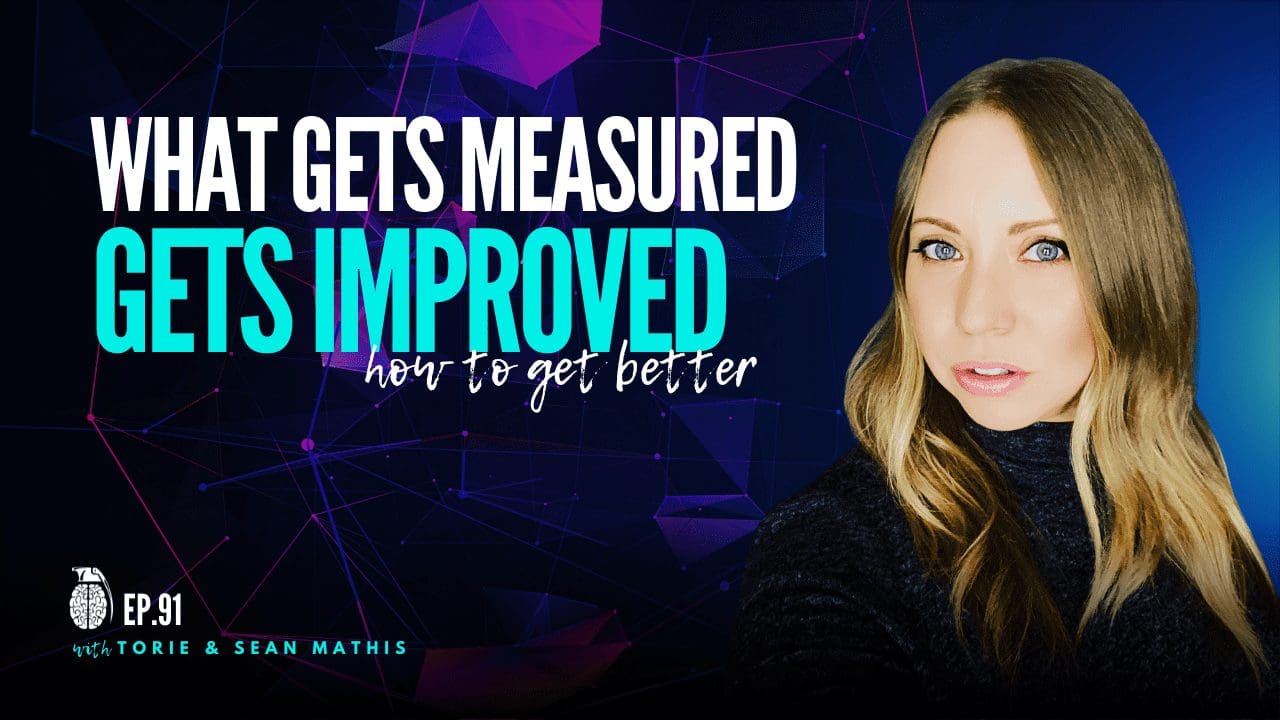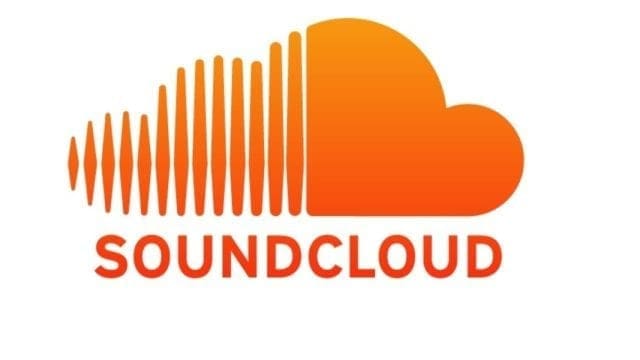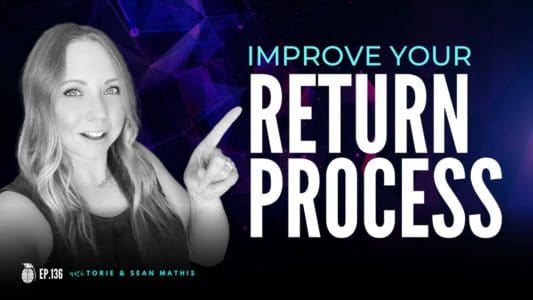Ep. 91 What Gets Measured Gets Improved

What Gets Measured Gets Improved
Peter Drucker famously said, “What gets measured, gets managed.” But a better approach for business and life is “What gets measured gets improved.”
In this episode, Torie Mathis and her cohost Sean talk about the ways you can implement simple measurements to improve the growth of your business, the effectiveness of your marketing, your money, your health, and more.
And if you want to fight this approach because you don’t like numbers or you have a fear of negative results, we have tips for you too.
Full “what gets measured gets managed” quote: “What gets measured gets managed — even when it’s pointless to measure and manage it, and even if it harms the purpose of the organization to do so” – Peter Drucker
Mentioned in this episode: 75 Hard
https://andyfrisella.com/pages/75hard…
Listen or watch the full episode below:
EPISODE TRANSCRIPTION –
(transcription is auto-generated)
SAF 91
Torie: [00:00:00] It’s okay. When things dip because that gives you information that you need to make different decisions.
Hey, you guys, what’s up this Torie Mathis and I’m here with the one and only Sean Mathis, founder of Miles Through Time Automotive Museum.
Sean: [00:00:24] It’s all true.
Torie: [00:00:25] It’s all true Peter Drucker famously said what gets measured, gets managed. And I think that what is even better for business owners is what gets measured, gets improved.
And actually not just business owners. I think anything that you want any goals that you want to reach, anything that you want to do better? I think what gets measured gets improved. If you can’t measure it, there’s no way that you can improve it. You always have to know where your starting point is.
You need to be like one of those maps, or you go to a trail and it says, you are here. If you don’t know where you are or you know how you are this week compared to last week, there’s no way that you’re going to be able to improve. And I think the thing is that not only are you not able to improve, but I guess you’re not able to see if you’re doing worse either, which I think might be some reasons why some people don’t want to be measured is that.
That’s a crappy feeling when you see that what you did this week is worse than what you did last week. But if you’re serious about reaching goals and serious about growing your business or getting stronger at the gym or losing weight or whatever these things are like you have to measure.
Sean: [00:01:33] I think people get caught up on, on measuring what it, whatever it is they need to measure and have this negative. Aspect about it, or, if they go down, and that’s bad, then they feel bad about themselves. Where if you. Do it more measure it as a game, and there’s going to be ups and downs and it doesn’t matter. You’re tracking, you’re just tracking progress. It’s a game.
It’s not that big of a deal. If it goes down and you want to go up, then you’ve got a goal of making it go up and vice versa. You don’t need to get caught up on I wanted to lose five pounds and gain too. Fuck it. I’m going to quit.
Torie: [00:02:09] You know what that like the gaining weight thing it’s really good to track that because then you realize two pounds gain two pounds was like, it happens all the time. Like in that it’s just a normal thing. Whereas if you only did it once and you’re like, shit, I’ve been working out for two weeks really hard and I gained two pounds. It just might be a day that, or the time of day that you just happened,
Sean: [00:02:31] what were you doing that day and track more to see what’s going on,
Torie: [00:02:35] girls aren’t like that. It just, it happens. I could be 2, 3, 4 pounds heavier in the later in the day or at a different time of the week. It just happens. But if you didn’t track, like you would not know that and know that just normal fluctuations happen. And then once you do know that, and it doesn’t upset you, if you do gain a pound or two.
And I think it’s just your website analytics or your email, we talk about unsubscribes people are going to unsubscribe. And if you don’t want to look at your analytics because you don’t want to see that people unsubscribed like what? But once you look at it and you’re like, oh, people always unsubscribe, then you just know that’s just part of it.
Sean: [00:03:16] People also spam you, even though they signed up for it, they have the ability to unsubscribe from it. They’ll still spam. It.
Torie: [00:03:26] Absolutely.
Sean: [00:03:26] I try my damnedest not to let it irritate me, but man, just unsubscribe.
Torie: [00:03:31] You know what? Even on subscribing, I think it really irritates people and makes them not want to email because their list is so precious that. That it’s hard to get over that, but just like you might gain a pound or two, just because of, just natural occurrences, you send out emails. If you have an email list, like people are going to unsubscribe and there’s gonna be some people that spam you, but there are other things like that you could do.
If you, things that could be measured that could be improved. One of the things, if you wanted to lose weight, a really great thing is tracking what you eat, because most people don’t realize what they eat.
Sean: [00:04:09] Sounds like a whole lot of work.
Torie: [00:04:11] It is, but it is crazy that once you do track it, they have like things like my fitness pal and stuff like that. And I know you’ve never done that, but like when I got pregnant and after I had my babies, that was one way that I lost weight is that I tracked. Exactly what I ate and I put it all in there and I was able to, don’t need to eat that today. Need to eat more and track how much I, and it really, once you get used to it, it’s not as bad.
And I think tracking anything it’s like that, like once you actually start, like Sean says, then it’s a game. And you can make it fun and challenging. I’m like, what can I do this week? It’s like when we got our first hybrid, wasn’t that the greatest?
Sean: [00:04:47] Yeah. Trying to see how high miles you can get.
Torie: [00:04:51] It actually has a little display on there that tells you what your miles per gallon is. If you there’s like a way that you can feather the gas pedal so that you just give it a little bit of gas and then let the electric motor takeover, or when you’re actually breaking or not gassing, it’s charging the battery again. And it shows it all. It’s very visual. So it’s really fun to see like how high you can get your gas mileage.
Sean: [00:05:14] It’s not the funnest way to actually drive, you’re trying to consider yes, you can occupy that fun level on a different one. Different level.
Torie: [00:05:23] But I think that anything that you want, improving your gas mileage was a thing like, and you thought that was something that, you want to do. There’s a way to, to make it a game to do that. I think that’s cool.
Sean: [00:05:33] When I worked for Pepsi, I was a service tech, so I’d go in and fix fountain equipment and vending machines and coolers, and they had this. This way to measure everything and they put it to a traffic light. So you’d have green was good, yellow, you could improve and red was bad and they had all these different measurements, response time and your fixed rate and How are, if you went back within a too quick of amount of time, two for a call back.
So they had all these different things and you could see everybody, they’d post them every month and you’d see all these little different blocks of all the categories. And they were all different colors, red. And it looked like a Christmas tree. It drove me nuts, to have any red on there or any yellow, really.
So I, I did, I completely turned it into a game just personally, not trying to do better than anybody else. I didn’t actually even care about the number itself, as long as the color went green. And my goal was to make it solid green.
Torie: [00:06:32] Were there people that were pissed off about the tracking or anything like that? Or that everybody was public?
Sean: [00:06:37] No. This was in California when it first started. So like it’s, it was always there as far as long as I was, there is I would do what I, trying to manipulate the numbers, but knowing consciously what I had to do to make those numbers green. I was actively doing that.
So from a company standpoint, I was a model employee because I was wanting to do that. Cause I turn it instead of having the mentality a lot or measuring the shit and I don’t want to do it. And I was like, man, I want that thing solid green. And I actually. It gave me something to do.
Cause I was going to be able to do my job no matter what anyway, but this gave me something I’m like, oh, let’s see how good I actually did. And cause some of them, the callbacks were the hardest one because if it was something I didn’t fix and somebody had, if I went back out to it within 30 days, I would know I’m a man.
I was just out here, but I then figured out how I can still make it so that I switched the numbers over to something else. And I could still manipulate the numbers to make it good. But if somebody else went out there and they wound up fixing the same piece of equipment and it dinged my numbers, which sucked But then when I went and I switched to a different Pepsi place on the other side of the country, the numbers, the number game, wasn’t quite as I wouldn’t call it popular, but embraced.
They didn’t really embrace it. They were like they were there. It was the same thing. They still did it, but nobody actually gave two shits about it. So when I first got there, I’m coming from an area where We’re all competing for solid green. Everybody, even the new guys that are, they’re getting up there and they’re getting all these green numbers and I go to the east coast and it’s, everybody’s solid red.
Like absolutely. If it was any color, other than red shit was a fluke. And it didn’t settle well for me. So I immediately tried to do the same thing I did on the other side of the country. And I wound up getting it green within the first month. And that location, it did not come for a while. Cause nobody, nobody was doing it now.
All of a sudden I go in there and I’m like, and I show that it’s possible. Yeah, there is not. There was not a warm, welcoming for that, but I didn’t care because it’s still, it gave me personally something to do. And really from a company standpoint, like they need to do that or they need to hire some other people because it, it did it, it helped Higher the expectation of the quality of work.
Torie: [00:09:15] I asked if some people were upset about it because I’ve always heard that like people that are your superstar employees, like they want to be measured, they want to do great. They want to turn it into a game. And then there’s some people that they want to low lay low. And do the least amount that they can and just breeze by there’s lots of breeze by people.
And those may not be like your star employees. And those people do not want to be measured to me.
Sean: [00:09:39] I was like, why the hell are you here? Then it drove even the Miles Through Time right now I check the numbers of who visits the museum every day. Every single day I wait until the numbers come through and I keep tracking it.
So I know exactly how many people would come in to visit the museum. And then what I do is I consciously try to think No numbers are low this week or this month. And then, maybe we need to do an extra event or I need to promote extra hard or do something so we can get those numbers up and then keep them up and then keep, and then higher raise the goal of how many people are actually coming in.
And if anything, just track the progress of people the awareness, right? The awareness of Miles Through Time is huge in the heartbeat, the hardest aspect of this. So if I can actively see the numbers going, okay, people are knowing about the museum. My Facebook ad is working cause they’re going in there.
And it all works together where. If I just be, especially since I’m not there on a daily basis, that I didn’t have anything to measure like I’d have no idea what was going on.
Torie: [00:10:38] Just a number when you get a check at the end of the month, or, you know what your bank account is at the end of the month.
And that’s not good enough, talking about like we were talking about the two pounds like maybe that’s just a natural flow in tracking the numbers. You wouldn’t then know. Oh, this month is a little bit slow or this time is a little bit slow. And then knowing that there are those slow times as a way that you can prepare for the next year and go, oh November, I don’t know.
He’s always slow. So what can we do? Maybe that is when we need to do a car show or we need to contact car clubs and be like, you need to come in November for sure. Whatever reason. So it gives you a way that like it’s okay. When things dip because that gives you information that you need to make different decisions right.
In the future right?
Sean: [00:11:22] Yeah.
Torie: [00:11:22] I think that’s a thing that so not only is it like helping you improve, like it’s helping you plan things and I think you need that data. You need to have that information. Can you talk about a, you look at the numbers every day. I have a thing, ever since we started our podcast.
And so we put our podcast also on YouTube. So I don’t know where you’re listening to this, but it might be on a podcast player. It might be on YouTube. We upload the videos. Also, I’m starting to get those onto Facebook and Instagram. So that way it’s just out there everywhere. And so the most important ones are the podcast and then also on YouTube.
And so every single week, Monday morning. The first thing that I do is I write down how many subscribers I have. I do, how many plays we have on our podcast. And then I have this really cool software that tells me in the entire United States for business podcasts, like where we are actually at, like on the charts and then for the entire world where we’re at.
And so I can track that also and see did we grow this week? Did we not grow this week? If we did grow a whole bunch, like what happened? What was the The episode that maybe got a lot of views. And so I’m able to go in there and see what actually happened. And there been like a couple of wildcard episodes that have done a lot better than others.
Why I have no idea, but because we’re still, still in the new stages of this, that’s going to be data that we’re going to be able to know and be able to look at and see, what we can do in the future. Because if we didn’t look at it, if we didn’t measure it, if we didn’t go over the data, we would have no idea on how to make it better.
Sean: [00:12:49] Yeah. The most popular episode was that YouTube video where we were both in bikini tops, not going to tell you which episode it was. I have to go through all of them and just find out which one of that is
Torie: [00:12:59] going to be like the greatest one.
Sean: [00:13:01] We didn’t do it through the whole episode, it was just like a moment there. So you’ll have to find it. So just listen and you’re going to want to watch it.
You’ll
Torie: [00:13:08] have to go to YouTube and watch and listen to it on the podcast.
Sean: [00:13:12] See you never know if you can find it.
Torie: [00:13:15] What else do I have here? Another really great place that you can measure and get a lot better is for savings and investments, or just knowing, like tracking how much money that you are spending.
If you want to spend less money, whether it’s at your business or personal, if you actually track every single dollar that you spend and track every single dollar that comes in as a really great way to know exactly where you’re spending. Cause sometimes you’re spending money on crap that you didn’t even realize, especially when you have things on your credit card and recurring billing, like that’s something that you really have to go back and look through because there are things that they’ll be charging you forever stuff that you’re not even using for your business.
Or yeah, maybe we got a little too crazy on our Amazon subscribe and save. If we need to cut back a little bit, it is a good way of doing it. Yeah. That’s another thing that I track weekly is I look at our stocks and I look at our savings and see, what’s going good. So that way I can make better decisions for what’s going on.
But if I didn’t look at those things every week I wouldn’t know. And we actually, we got Riley. I made a custodial stock account for him in our investment account. And so now he’s able to go in there and see how his, he picked his own stocks. I gave him a hundred bucks. He picked his own stocks. He went through the process and he bought stocks.
So we have a little twelve-year-old stock trader needs to put a little bit more money in there. And so now, trying to get it so that he can go through and hopefully I can get him on a better. Rhythm of checking it a little bit more often, but probably it’ll be more exciting when there’s more than a hundred bucks in there, but still it’s something that he’s able to look at and able to see how it’s doing.
Sean: [00:14:53] The biggest thing is numbers by themselves can be less than super exciting. But the moment you can start comparing the numbers to the same numbers. That’s when it gets exciting to see, you like the museum, for example, if I can compare February and February with each other and we’re doing that much better, that’s awesome.
Because if I’m just looking at February’s number and I have nothing to compare it to. They’re just numbers to me that I can compare a day to day, but day to day. That can be super different. Whereas when there’s holidays or different events that go on, I can really start to then hone that in and compare major chunks and really then be able to make decisions that will then.
Hopefully increase what that number is that I need to go up.
Torie: [00:15:46] I think maybe if you’re not like a numbers person, maybe you like visuals better. I really like Google analytics because you can do month after month over month. And they’ll actually visually show you in two different lines, like one line color and the other line color, and you can compare two different times.
So there are ways that you can get your data and your analytics and things like that in more of a visual way, if like numbers just aren’t really your thing. You had a really good tracking that I really liked. I did 75 hard in the fall. And if you want to talk about like tracking and measuring, I thought it was a fantastic program.
Just because of how much you had to track and how many tasks you had to actually check off. If you want to check that out, I did a whole episode on 75 hard and I will link to that. But you had to not only do all of the different tasks that you have every day, but every single day, you had to take a picture of yourself.
And so that was a way that like day after day, like you’re like, oh great like another picture. Like it’s going to be different than yesterday or the day before, but once you got weeks in between there, and then, a month in between there, then you really started to see that data. And that’s all it is data.
That data really started to make sense. So though the numbers and tracking and measuring may not be exciting in the first week or in the first two weeks, like Sean said, once you have a little bit more time in between there, and you’re able to see things that are happening or ways that you can compare them to the same exact time, or see some patterns that are starting to evolve, then the numbers get to be a lot more exciting and then you can make really good informed decisions.
Sean: [00:17:15] Yeah. So moral of the story is not to quit on the numbers so quickly. It’s wait or any of that kind of stuff. Like it’s really easy to go. This is a ton of work and I don’t see the point. You’re not seeing any difference. Day-to-day may not be enough of a difference. And you’re like, this is pointless.
Just keep going, just keep doing it and doing it. And then once you start seeing those weeks and months, if not years span differences, you’ll go hell, I’m glad I have that data, because then you can start making some intelligent decisions.
Torie: [00:17:47] Then you’re going to be like, damn, I wish I would’ve did this sooner. And I would’ve had more data to learn.
Sean: [00:17:52] There’s all kinds of stuff. I wish we had more data that went back farther. It just. Yeah. You only know when you know and what to do with it from then on is your decision.
Torie: [00:18:02] And just because you see a dip in numbers or you see something negative, like that doesn’t necessarily mean that it’s a bad thing. Gaining a pound or two, or having some unsubscribes or having a slow month, that’s not like a bad thing, and it’s not something to turn your head to. That is data that can help you. Maybe it’s just an ebb and flow kind of thing. Maybe it’s something that you need to take action about. There’s different things that it can mean, and it doesn’t does not mean quit.
It doesn’t mean stop looking at the numbers or stop weighing yourself or stop, doing whatever it is that you’re trying to track. If you liked this episode,
So if you liked this episode. I would appreciate it. If you would leave us a review and share this episode with somebody that, we have new episodes that come out every single Tuesday and Thursday so that we hope that you’ll join us back here. Again, you can find us on any of the podcast players, and we’re always on YouTube.
You can find us that you can see our shiny faces and we will see you on the next one. Thanks.
Do you want to get smart tools to build your business? You have to go to getsmartaf.com
About Digital Marketing Expert Torie Mathis

Torie hosts SMART AF, a show for non-techy entrepreneurs looking to grow their business, with her husband Sean and is the creator of SMART AF Magazine. Learn from Torie at the Smart Arsenal and on her channel.
Hi! I'm Torie!

You don’t need crazy tech skills, buckets of cash, or dedicated staff to market your business. You don’t even need a lot of time.
What you need is to be SMART.
Smart Marketing For
Get Smart AF
DELIVERED TO YOUR INBOX
from your Digital Marketing Coach Torie Mathis!
Let's get SMART!
Let's Connect!

*Posts may contain affiliate links. If you use these links to purchase, I may earn a commission at no additional cost to you.







 I help entrepreneurs learn digital marketing.
I help entrepreneurs learn digital marketing.

